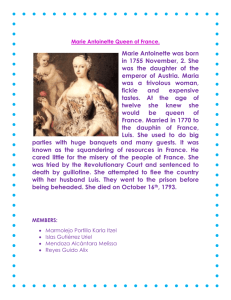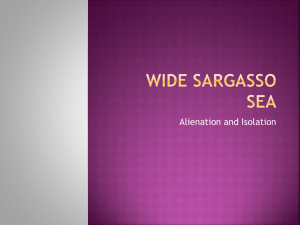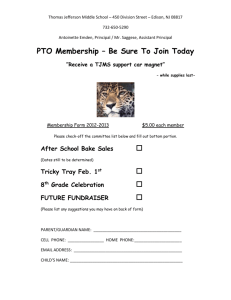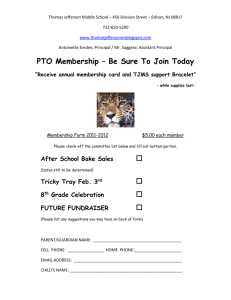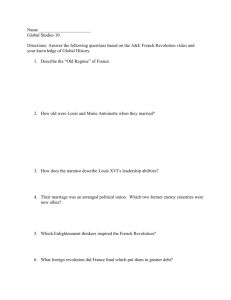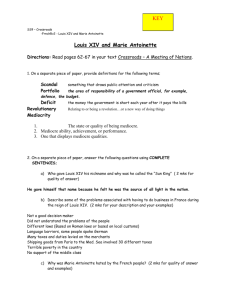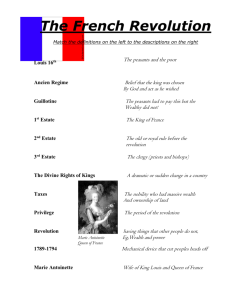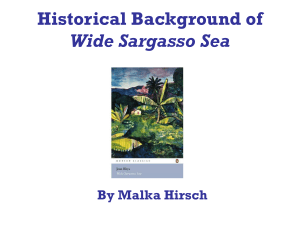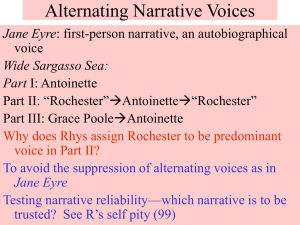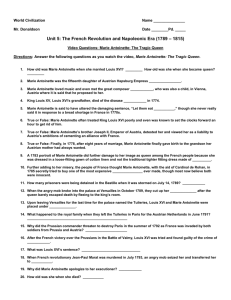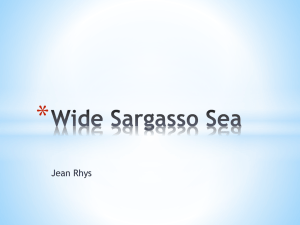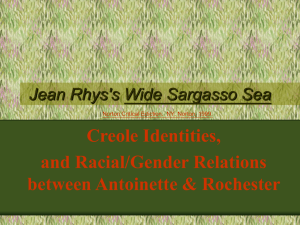Symbols in WSS - Mrs
advertisement
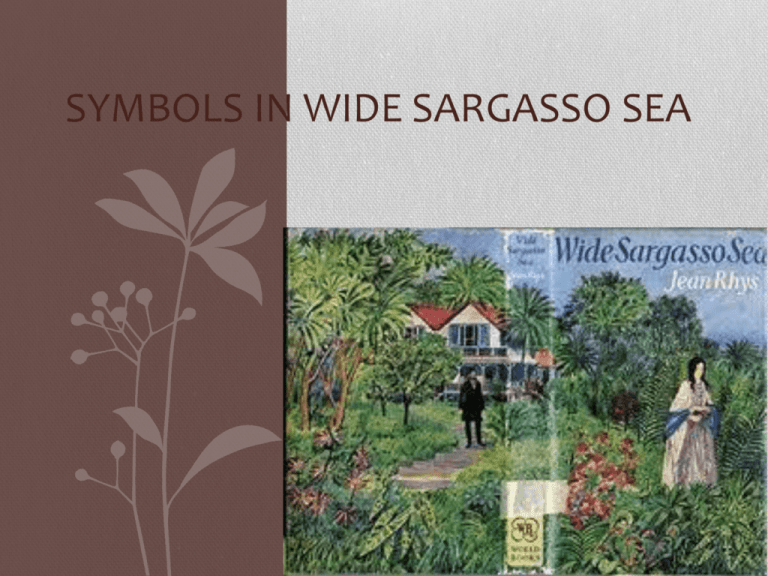
SYMBOLS IN WIDE SARGASSO SEA Mirrors… • Mirrors and representations of reflections recur throughout the text. They are linked to identity and images of the past. …at Coulibri… • Annette is reminded of her poverty and vulnerability everytime she [passes] a looking glass. • Antoinette’s favourite picture, The Miller’s Daughter, acts as a sort of reflection. It is possibly a projection of who she wishes to be- a proper English girl- so when it is destroyed readers can assume that this is the closing of this life to her. …in the attic… • There is no mirror to reassure Antoinette of her existence. There is no looking-glass here and I don’t know what I am like now. I remember watching myself brush my hair and how my eyes looked back at me. When she does finally encounter a reflection at Thornfield, she does not know how to interpret it. As she dreams of burning down the house, Antoinette, encounters a ghost in a gilt frame. She vaguely knows herself, claiming but I knew her, yet she cannot give the ghost (or herself) a name. • Ultimately, the mirror’s reflective surface represents Antoinette’s inability to reconcile the different parts of herself. This expands upon the idea that there are two very separate parts to Antoinette’s personality- the side that acts rationally and the side that lashes out as illustrated in her ability to recall attacking Richard Mason. • Long ago when I was a child and very lonely I tried to kiss [my reflection]. But the glass was between us- hard, cold, and misted over with my breathe. Now they have taken everything away. What am I doing in this place and who am I? • Society cannot allow her to exist as an independent married woman, or as a proper English woman with her own desires. Birds… • As Coulibri burns Coco fruitlessly searches for a way to safety. In his final moments he falls to the ground below on fire- a death that is later paralleled by Antoinette (at least in her dream and in the details given in Jane Eyre). • Coco, a bird of paradise, has his wings clipped by Mr Mason (an Englishman) and the bird is shackled- this is ultimately mirrored by Antoinette’s own incarceration by Rochester. • [Coco] made an effort to fly down but his clipped wings failed him and he fell screeching. He was all on fire. …at Granbois… • A second incident that includes a bird signals betrayal, a warning to Antoinette. The symbol is meant as a warning, a signal that danger is imminent. • That is for betrayal, but who is the traitor? Fire… • Oh my god, they get at the back, they set fire to the back of the house. • The fire motif begins with the fire at Coulibri. The fire helps us explore the ideas of slavery and dependence that are connected to the theme of racism. In an attempt to rid Jamaica of the relics that represent the old ways of slavery, the ‘black’ Jamaicans come together- their anger is heard as they set fire to the homestead. • At the end of the novel Antoinette dreams of setting fire to Thornfield Hall. Readers with prior knowledge of Jane Eyre know that she does this very thing. As readers we assume that fulfilling her dream is Antoinette’s intention- something she accomplishes. • I dropped the candle I was carrying and it caught the end of a tablecloth and saw flames shoot up. • Some critics suggest that Antoinette’s leap from the roof of Thornfield is her taking back control of her life, her freedom. What do you think? • Fire is seen to represent enlightenment and the movement toward action- the flame flickered and I thought it was out. But I shielded it with my hand and it burned up again to light me along the dark passage. • Within Part Two of the novel Rochester describes the use of candles at night. At times the flames of these candles are seen to draw moths towards them. The moths helpless to resist the flame burn themselves. The description of the moths draws parallels to Coco who is killed in the fire at Coulibri. • In Part Three we see that fire continues to hold a fascination for Antoinette- not simply as a source of warmth but also as something that she is able to watch and lose herself in. Flowers… • The garden at Coulibri is filled with flowers. All the flowers in the world were in our garden, and sometimes when I was thirsty I licked raindrops from the jasmine leaves after a shower. • Although the descriptions of the flowers illustrate their beauty it also suggests that they are fragile. The fragility of the flowers allows them to be linked to the idea of mortality. The paths were overgrown and a smell of dead flowers mixed with the fresh living smell. They also symbolise Antoinette expressing her beauty and fragility. Nature is something Antoinette has a close affinity to. As Coulibri is destroyed she notes that nothing would be left worrying about the orchids, the ginger lillies and the roses the very thing that makes Coulibri familiar to her as well as her home. • The frangipani becomes a bad omen… the first time we come across it the delicate flower is linked to death as Antoinette finds Annette’s horse dead beneath the frangipani tree. • Later, after their wedding, two frangipani wreaths are laid on their honeymoon bed. The wreath links Antoinette’s marriage to her eventual death. •It is also worth noting that Rochester carelessly tramples on the wreaths- this is similar to the way in which Rochester carelessly tramples on Antoinette’s fragile hopes. •Frangipani is also smelt on the red dress Antoinette seeks in the final pages of the novel. • The two pink roses that Christophine brings to the couple after their first night in Granbois represent both Rochester and Antoinette, although one of them is in full bloom (it has been suggested that the flower in bloom symbolises Antoinette’s passion for life). • When Rochester touches the rose one of the petals falls off, and he instantly thinks of the poem and the saying that all beautiful things have sad destines. • Here the link between Antoinette and the flower is clear- Rochester’s thoughts sadly foreshadow Antoinette’s life- her life is destined to end in a firey death as predicted by Jane Eyre. • Flowers are seen to be the only colour mentioned within the walls of the convent. • The link between Antoinette and flowers is even more blatant after Rochester reads Daniel Cosway’s letter. As Rochester passes some orchids he thinks of how much they remind him of Antoinette, and proceeds to break a spray off and tramples it in the mud.
